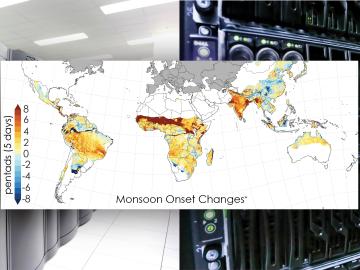
Filter News
Area of Research
- (-) Nuclear Science and Technology (9)
- (-) Supercomputing (90)
- Advanced Manufacturing (8)
- Biological Systems (2)
- Biology and Environment (128)
- Biology and Soft Matter (1)
- Computational Biology (1)
- Computational Engineering (2)
- Computer Science (11)
- Electricity and Smart Grid (3)
- Energy Science (184)
- Functional Materials for Energy (1)
- Fusion and Fission (9)
- Fusion Energy (2)
- Isotope Development and Production (1)
- Isotopes (3)
- Materials (126)
- Materials Characterization (1)
- Materials for Computing (20)
- Materials Under Extremes (1)
- Mathematics (1)
- National Security (32)
- Neutron Science (129)
- Quantum information Science (9)
- Sensors and Controls (1)
- Transportation Systems (2)
News Topics
- (-) Bioenergy (9)
- (-) Environment (23)
- (-) Grid (5)
- (-) Machine Learning (15)
- (-) Materials Science (19)
- (-) Neutron Science (17)
- (-) Quantum Science (25)
- (-) Transportation (6)
- 3-D Printing/Advanced Manufacturing (8)
- Advanced Reactors (12)
- Artificial Intelligence (37)
- Big Data (22)
- Biology (11)
- Biomedical (19)
- Biotechnology (2)
- Buildings (4)
- Chemical Sciences (5)
- Computer Science (97)
- Coronavirus (14)
- Critical Materials (3)
- Cybersecurity (9)
- Energy Storage (8)
- Exascale Computing (26)
- Frontier (32)
- Fusion (9)
- High-Performance Computing (43)
- Isotopes (7)
- Materials (15)
- Mathematics (2)
- Microscopy (7)
- Molten Salt (5)
- Nanotechnology (11)
- National Security (8)
- Nuclear Energy (39)
- Partnerships (1)
- Physics (10)
- Polymers (2)
- Quantum Computing (20)
- Security (6)
- Simulation (16)
- Software (1)
- Space Exploration (8)
- Summit (43)
Media Contacts

ORNL researchers have developed an intelligent power electronic inverter platform that can connect locally sited energy resources such as solar panels, energy storage and electric vehicles and smoothly interact with the utility power grid.

From materials science and earth system modeling to quantum information science and cybersecurity, experts in many fields run simulations and conduct experiments to collect the abundance of data necessary for scientific progress.

Five researchers at the Department of Energy’s Oak Ridge National Laboratory have been named ORNL Corporate Fellows in recognition of significant career accomplishments and continued leadership in their scientific fields.

Scientists at ORNL used neutron scattering and supercomputing to better understand how an organic solvent and water work together to break down plant biomass, creating a pathway to significantly improve the production of renewable

Scientists from the Department of Energy’s Oak Ridge National Laboratory and a dozen other international research institutions have produced the most elaborate set of projections to date that illustrates possible futures for major monsoon regions.

A team of researchers has performed the first room-temperature X-ray measurements on the SARS-CoV-2 main protease — the enzyme that enables the virus to reproduce.

The Department of Energy’s Office of Science has selected three Oak Ridge National Laboratory scientists for Early Career Research Program awards.

Scientists at the Department of Energy Manufacturing Demonstration Facility at ORNL have their eyes on the prize: the Transformational Challenge Reactor, or TCR, a microreactor built using 3D printing and other new approaches that will be up and running by 2023.

Scientists have tapped the immense power of the Summit supercomputer at Oak Ridge National Laboratory to comb through millions of medical journal articles to identify potential vaccines, drugs and effective measures that could suppress or stop the

For the second year in a row, a team from the Department of Energy’s Oak Ridge and Los Alamos national laboratories led a demonstration hosted by EPB, a community-based utility and telecommunications company serving Chattanooga, Tennessee.


